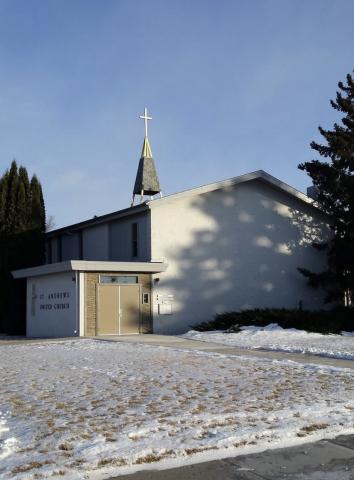Rev. Aurora Espenant on how embracing hope and a radical welcome have helped her rural church flourish rather than decline.

My name is Rev. Aurora Espenant and I have been the minister of St. Andrew’s United Church in Outlook, Saskatchewan since September 2022. Outlook is a small town of a little over 2,000 people about an hour south of Saskatoon, with strong agricultural roots. St. Andrew’s United Church is a flourishing community of faith, and I want to share our story of abundance with the hope of creating constructive and collaborative dialogue and connection. I feel that rural churches are not always given a strong platform in conversations about thriving churches, leaving many wondering where they fit. My goal is not to treat our story of flourishing like a checklist or a one-size-fits all recipe, but rather to get you thinking about your own sources of abundance. So here are four reasons why my rural church is growing:
1. Leadership that embodies hope and enthusiasm
For me, being a leader means giving people tools so that they can effectively determine for themselves who they want to be. The kinds of tools I give are going to influence what can be built. If I offer tools of despair or decline, they likely won’t be able to build anything. As a result, I choose to provide tools of hope at every possible turn. It sounds odd to say that I practice hope aggressively, but that is how I would best describe what I do. I strongly believe that in healthy pastoral relationships, leaders see reflected back to them what they put in, even if the effects aren’t immediate. Hope is contagious, and the leader sets the tone. I am not trying to say that having the right mindset is enough in and of itself to lead to growth, but it is nonetheless an important piece of the puzzle.
2. Cultivating a culture of welcome
Admittedly, this is something that the people of St. Andrew’s excelled at from the moment I began as their minister. I have never seen someone attend their first service here without being acknowledged. People will sit in a different place than usual to introduce themselves to a newcomer and walk them through pieces of our service. Small things have a big impact when it comes to welcome. For new people, it might start with something as simple as remembering their name. For people who have been part of the church for a long time, an essential piece of ensuring that they continue to feel welcome is taking the time to directly express gratitude for the gifts that they offer the church. A big part of welcome is ensuring that people feel valued.
3. Presence in the wider community
A key question we ask ourselves at St Andrew’s is: if we disappeared, would the surrounding community notice? It’s important to us that the answer is yes. There are three key components that come to mind as I reflect on this. The first is extending and accepting invitation in equal measure. The reality is that often just extending invitations to the community is not enough. When we are first intentional about attending community events as people of St. Andrew’s, the invitations we extend are more likely to be met warmly. The second piece is equipping people to talk about the positive impact that the church has on their lives—not just why they are Christians, but being able to share that “This is what is so great about St. Andrew’s”. The third component is that my congregation has been exceptionally supportive about me providing pastoral care support for surrounding communities. I have provided pastoral care in nine different communities over the past year. This is one of the biggest ways we can use the resources we have to make the biggest impact possible. Which leads into the final piece….
4. Working with what we have, instead of wishing for what we don’t have
A good starting point for this is to ask yourself, "What are we already doing well?" When you have identified those things, put even more energy there! You can put a little bit of energy into a lot of different things and not make progress in any of them, or you can put a lot of energy into a few things and see a lot of progress made in all of them. What this looks like will be different for each congregation, as all have different areas they excel at based on the minister and the gifts of those who attend. For us at St. Andrew's, this currently looks like putting a lot of energy into seniors’ programming and music. We don’t have a lot of the things that are traditionally associated with thriving churches—for instance, children or youth programming. But we’ve stopped buying into the narrative that thriving churches must fit inside a very narrow box. We’ve identified our best gifts, and have used them to live into what flourishing means for us!
And so, what fruits has all of this produced for St. Andrew’s United Church? Worship attendance has doubled since 2023, and Christian education participation has tripled since 2023. We are on track to have our first deficit-free year while employing a full-time minister in over a decade. And we’re a community of believers with renewed hope for the future and trust that God is with them.
If you are also in rural ministry leadership, or are part of a rural church and want to connect, I would be more than happy to have a conversation with you. You can reach out to me at aurora.uc.outlook@sasktel.net.
—Rev. Aurora Espenant is minister at St. Andrew’s United Church, in Outlook, Saskatchewan.
The views contained within these blogs are personal and do not necessarily reflect those of The United Church of Canada.